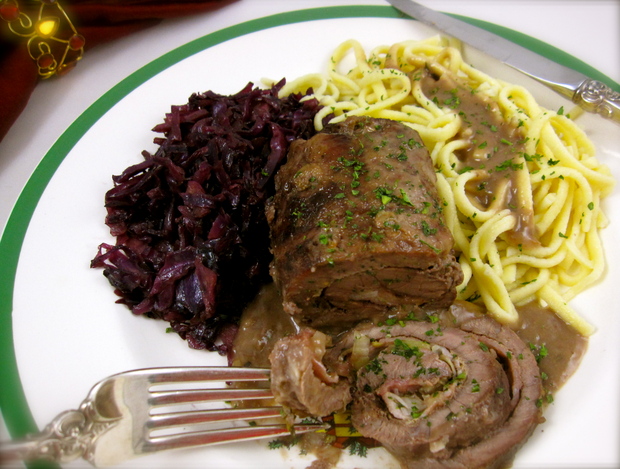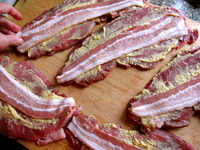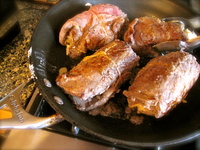Peggy Lampman's Thursday dinnerFeed: Rouladen (German Beef Rolls)

Rouladen (German Beef Rolls)
Peggy Lampman | Contributor

German legend brings magic to the Christmas Eve landscape. On this holiday, according to various websites, rivers turn to wine, animals speak to each other and the mountains open to reveal precious gems. Even in the depths of a wintry day, blossoms on the trees are filled with fruit.
There is one condition: only the pure of heart can be a part of this magic.
Whatever your holiday traditions may be, they are more than likely linked with particular recipes, the German culture being no exception.
Much traditional German holiday food has been borrowed by the rest of us. Christmas goose, stollen, mulled wine and star-shaped cinnamon cookies are a few German holiday treats that have graced my table in Christmas celebrations.

Next: Add chopped onion and dill pickles, if using.
A century ago, according to a Grace Shackman article in the Ann Arbor Observer, German immigrants and their descendants were Ann Arbor's largest ethnic group.
Richard Bailey, an English professor at the University of Michigan, writes the long-standing influence of Germans in Ann Arbor showed up at restaurants such as the Heidelberg, Metzger's and the, now defunct, Old German. On Ann Arbor's east side lived the English, and on the west side, the Germans.
"Until well into the 20th century, you could expect to hear English spoken on State Street and German on Main," writes Bailey, found on the website www.speroforum, The Germans of Ann Arbor.
I've been a part of many German Christmas celebrations in Ann Arbor, and one favorite dish, rouladen, was always the centerpiece. There are many nuances to the preparation of rouladen, but there are commonalities to most recipes. The cook spreads thin slices of beef with mustard and horseradish, arranges onions, bacon and pickle over them, rolls them, then braises the rolls in broth or wine until they are very tender. A gravy is made with the pan drippings.

Browning rouladen before braising.
It's a personal preference, but when using wine as a braising liquid, I omit the pickle, as in this recipe. If braising the beef rolls with stock, I center dill pickle spears in the roll with the bacon and onion.
According to wikipedia, traditionally the pan was covered and placed on a raised iron mount in front of an open fireplace for the slow roasting period. Today most cooks braise the beef rolls, covered, on top of the stove or in the oven.
I enjoy serving rouladen with sauteéd purple cabbage and spaetzle, traditional German egg noodles that are particularly suited for soaking up gravy.
As I write these words, my heart is pure. On Christmas Eve, as the legend promises, I will be able to ladle wine for the Christmas table from the Huron River and pick apples for my stuffing from a tree down the street. If my heart is not as pure as I imagine, there's always rouladen.
Fröhliche Weihnachten, (Merry Christmas)!
Cost: Approx. $33
Yield: 8 beef rolls
Active Time: 45 minutes
Bake Time: 1 hour or more
Ingredients
3 1/2 tablespoons German-style mustard or Dijon
3 1/2 tablespoons prepared horseradish
8 thin slices (1/4-inch thick) top round steak (approximately 11 by 4 inches each)*
8 slices bacon
1 1/2 cups chopped onion
8-16 pieces kitchen twine
3 tablespoons all-purpose flour plus extra for dredging and thickening gravy
2-3 tablespoons light oil, such as canola or vegetable
1/2 cup red wine
2 1/2 cups beef stock
1 teaspoon minced garlic
1 teaspoon minced rosemary
1 teaspoon minced thyme
*Call your favorite butcher in advance to have him cut the beef in slices for you.
Directions
1. Preheat oven to 300 degrees.
2. Combine mustard and horseradish. Divide and spread mixture thinly over one side of each beef slice. Place one slice of bacon across each. Trim bacon if necessary so it does not extend beyond edges of beef. Sprinkle with leeks or onion. Season with freshly ground pepper. Tightly roll and secure with kitchen twine in one or two places on roll.
3. Dredge beef rolls in flour. In a heavy-bottomed sauté pan, heat oil over medium-high heat until hot but not smoking. Working in batches, brown rolls on all sides, turning with tongs as required. Place browned rolls in baking dish large enough to accommodate 8 rolls.
4. Deglaze pan with red wine and whisk to remove browned pieces from bottom and edges of pan. Reduce wine over high heat a minute then reduce heat to low. Make a sauce by whisking 3 tablespoons of the flour into the wine and pan drippings. Slowly whisk in stock taking care not to let lumps form. Simmer, whisking occasionally, until thickened and stir in garlic and herbs. Season to taste with kosher salt and freshly ground pepper.
5. Pour gravy over beef roll and cover dish. Place on middle rack of oven and bake 1 hour, or until beef is very tender. (You may also simmer on top of the stove, if desired.)
6. Remove beef from gravy and tent with foil. If gravy is too thin, pour into a medium-sized sauce pan and slowly whisk in 1 tablespoon of flour. Whisking constantly, cook over medium heat until thickened.


Comments
Thor143
Mon, Dec 27, 2010 : 7:02 p.m.
What is the differance between browning and brazing? Is it the cooking temperature? I want to try this recipe! I'm just a single guy that likes to cook.